Travel
Cathedral Maria Nascente of Milan in Lombardy (Italy)
What would Milan be without its cathedral or the Duomo as the Italians call it, the inevitable sightseeing monument of the city!
I got the chance to see it twice in the last 8 months and discovered during each visit something more exciting about it.
Many 20th century writers such as Mark Twain, Percy Shelley and Oscar Wilde have written about their feelings after visiting il Duomo. All have their reasons for their likes and dislikes. Something is sure is that no one can remain indifferent while looking at its front facade.
Someone recently told me “it was as if the dome had been made for tourists”.
You can only be in awe admiring such a monument!
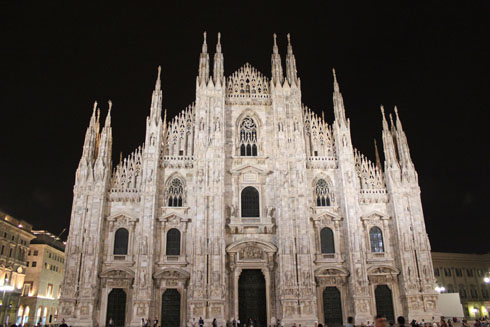
Milan cathedral by night
What stroked me the first time was of course the main facade but also the thickness and height of the pillars and the tall colourful stain glass windows of the choir.
But it is only from the cathedral’s terrace and roof that you can fully experience all the greatness and splendor of this place. On my way to the roof, I peaked through an open window overlooking the choir and altar. It was mass time and you could hear the beautiful singing. From the top I really fell in love with the rows of giant pillars and marvellous multi colored marble floor.
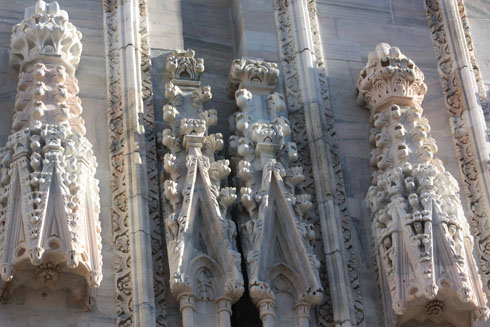
Crockets and pyramids
It is as if you have to make it to the roof to fully admire this work of art: the flying buttresses, the pinnacles and spires, the crockets, the bronze statue “the Madonnia” and the giants statues. If you are lucky enough to be there during a beautiful clear day, you will be able to see the Alps, the Po valley and many Milan buildings. Seeing the Duomo square from the roof and the many surrounding stores and sites are worth the way up too.
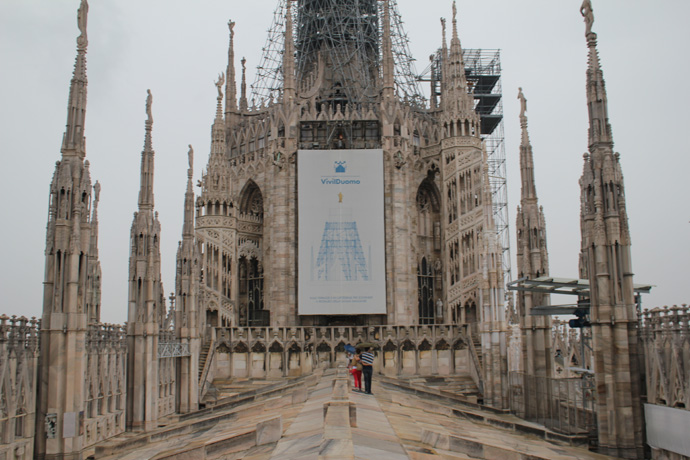
Walking on Milan cathedral’s roof on a rainy morning
About the construction and its building time:
The Milan cathedral was not built in one day! It took almost six centuries to be finished. With a beginning in the middle ages in 1386, a end was put in 1965, when the last gate was inaugurated.
Gian Galazzo Visconti (1351-1402), the duke of the time and cousin of the archbishop, Antonio da Saluzzo, started the construction of the cathedral (Fabbrica del duomo).
It was built to honour Mary. The sign in the outside “Mariae Nascenti” has been there since December 1810. It has a Latin cross Plan and its apse faces east.
The consecration of the Duomo was done around 1572-7 by Charles Borromeo, archbishop of Milan cathedral from 1564-1584.
Styles: Gothic, Romantic and Neo-Gothic
The cathedral started in the Gothic period with Gothic Rayonnant before going into flamboyant, also known as late Gothic.
A few periods have been named:
- At the beginning in 1386-1387
- Second period goes for a decade from about 1392-1402
- Sforza period with Francesco and Ludovico (1451-1520)
- Charles Borromeo period, which was slow
- Romantic Period with architect Francesco Croce (1696-1773)
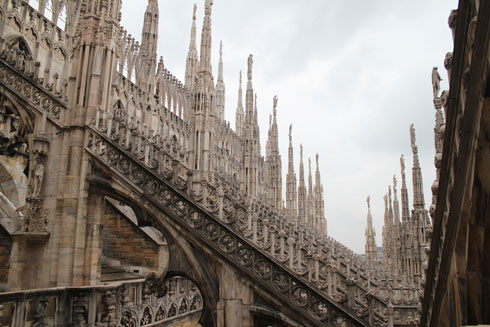
Flying buttresses and spires from the terrace of Milan cathedral
Neo Gothic or Gothic revival happened in the 19th century and also seen in Milan.
What was Gothic in the Milan’s cathedral?
- altar of Saint Catherine of Siena
- door in the Northern sacristy
- facade
- ribbed vaults
- pointed arches
- lancet windows
- flamboyant tracery windows
- “extreme” use of decorated pinnacles
One talks about Milan Duomo as “the European Gothic cathedral par excellence”.
Striking dimensions:
Surely the memory you will bring back with you is how big the cathedral is with its lentgh of 518feet/158 m. Its roof is enormous at 12,000 square meter and up to 40,000 people can enter it at once!
It is known as the first largest Gothic cathedral in the world and the second largest church in the world after the cathedral of Séville in Spain.
Among other things one will remember:
- 5 aisles
- 5 naves with over 50 pillars
- a nave of 147 feet/45 meters
- the cupola of the drum is 209 feet/64 meters high
- 150 gargoyles
- 500 steps to the Great Spire
- 55 stain glass windows
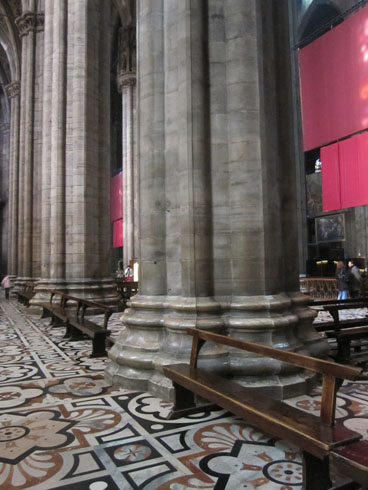
Pillars and marble floor inside of Milan’s Duomo
But who funded the cathedral, which took so long to build?
We know that many funds came from Pope Jubilee in 1390. There was also money from indulgences, the archbishop Antonio da Salezzo, the aristocrats of Milan and the citizens of Milan.
Marble:
The cathedral is made with pink marble and bricks. The marble comes from the Candoglia mountains in the North of Milan. The quarry was donated to the cathedral chapter by Gian Galeazzo Visconti.
The facade, ribs and floor for instance were made with it. Transportation of the marble was made by water on the Milanese canals and the first load arrived some time in 1388.
A look into the history:
According to a plate in the cathedral, the setting of the first stone can be dated to the year of 1386. At the time it was the Archbishop, Antonio da Saluzzo, who was in charge and the leader was the engineer, Simone da Orsenigo.
The Fabbrica del Duomo started when the Duke Galeazzo Visconti ordained its construction.
Many artists from Central Europe came to work in Milan.
We don’t know for sure who made the plans for the actual cathedral.
It was built on old sacred sites: St. Ambrose in the 5thcentury, basilica of Santa Tecla and Santa Maria Maggiore. It was later rebuilt in late 11th century after a fire.
The apse is the oldest part.
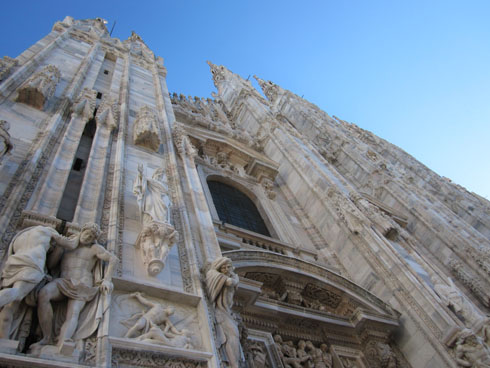
Cathedral sculptures – left side of front facade
The facade, which only debuted in 1590, was finished in 1805. That year, on May 20th 1805, Napoléon Bonapartre was crowned King of Italy there. He had ordained to finish it for the crowning ceremony.
The first facade (plans of Pellegrino Pellegrini and work of Francesco Richino) did not satisfy the people of the cathedral. It had to be redone, so a new plan from Carlo Buzzi was submitted in 1653. Even if the plan had been approved by the Council of the Duomo Fabrica, it was not pursued. It had to be redone. It took a while for the new plan and before it got started.
But the Napoleonic facade had to go too! There was a new competition in the 1800’s won by the Milanese, Giuseppe Brentano. He never finished his facade, which he worked on from 1886-88.
It was completely stopped in 1904.
What got done when?
- inauguration of the main altar in 1498
- cupola of the drum was completed during the time of Ludovico Sforza, finished in 1503; it took 120 years until completion.
- half of the dome was completed beginning of the 15th century when Galeazzo Viconti died in 1402.
- Great Spire was built from 1765-74
- the Napoleonic facade was ordained to be finished in 1805
- last outside bronze gate late 1960’s
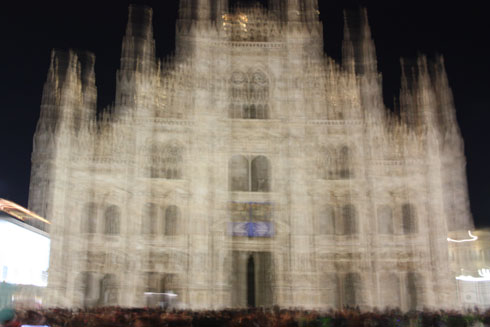
What to not miss:
- bronze doors on the facade – from left to right Arrigo Minabi 1948, Giannino Stiglioni, Ludivico Pogliaghi, Franco Lombardi and Luciano Minguzzi 1965
- great statues with gargoyles
- many beautiful marble altars such as the High altar/the Northern Transept, Center of the transept/ three altars from Pelligrino Pelligrini and the Gothic altar of St. Catherine of Siena
- presbytery
- 16th century wooden chair
- roof and terrace: take about one hour
- 12th candelabra from Nicholas of Verdun
- many sarcophagus
- organs of different sizes – first one is from July 1395
- all sculptures: oldest ones are found on the doors of the Northern sacristy – some detailed marble sculptures are in the apsidal ambulatory.
- Christian baptistery
- exhibit in the Duomo of magnificent canvases “the Quadroni” in November
- relics of Charles Borromeo
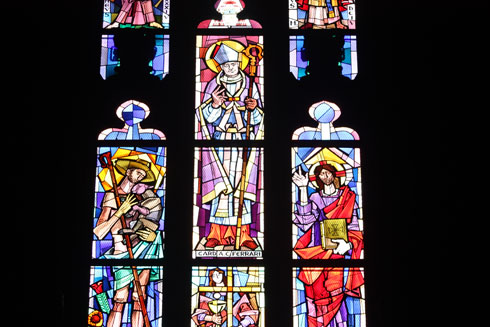
Modern stain glass windows
- details in the parapets in the South and North pulpits with new and old testaments stories
- pyramid and knot crockets decorating the outside of the building
- lancet windows located in the dome’s apse
- two beautiful statues from the 17th century in silver one from St. Ambrose and the other from Charles Borromeo
- Borromeo‘s remains are in the dome. He used to be an archbishop in Milan.
- Beautiful statues, spires and stain glass windows
Stain glass windows:
The stain glass windows of the Milan cathedral fascinates me. Here in Milan’s cathedral, there are no rose windows but ogive windows. I wish I could have come closer and spent hours looking at every little detail.
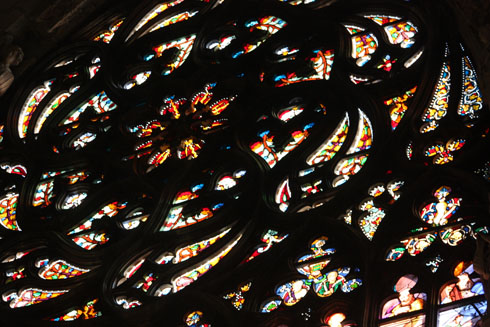
Stain glass window close up
A book sold at the cathedral tells you all you want to know about the stain glass windows.
Milan has the largest stain glass windows in the world in its choir.
What are they all about?
You will see scenes of political and religious life, the Old and New Testament, the history of David, life of saints and archbishops like St. Ambrose and St. Borromeo.
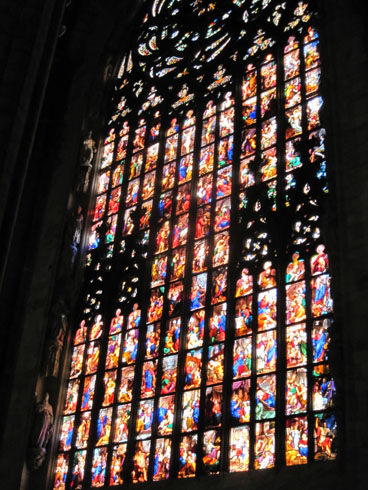
Large stain glass windows in the left transept
They were made by Lombard painters and master stain glaziers. There are not all from the Gothic period. Some windows were damaged in WWII and redone. Some have been restored too in the 19 century. Nowadays cleaning and restoring the windows is very important.
There is a large window in the apse. In the drum of the dome, don’t miss the eight ogival arches (1968). Also take a look at the very luminous ones from Giovanni Buffy (1939). Don’t leave without admiring the many details of three stain glass windows by the Bertini brothers in the ambulatory.
More names to be remembered:
- Michelino da Bezozzo, painter (1370-1455)
- Stefano da Pandino worked on the Apocalypse window in the 15th century
- Giuseppe Arcimboldi in the 16th century
- Pelligrino Pelligrini, Mannerist from Lombardy, architect of Charles Borromeo
- De Amicis 20th century
- Panigati 20th century
- Giovanni Hajnal: Hungarian artist worked on the windows in Neo-Gothic style in the 20th century
Spires:
With 135 spires and pinnacles, it will take you a while if you want to try to find them all.
It took 300 years to finish all spires.
The oldest one is called Giovanni Amadeo Spire because it takes the name of the architect and sculptor Amadeo (1447-1522).
You should also remember the Great Spire. It is the most famous one because it holds the statue of Madonnina, the protector of Milan. The statue is there since the 18th century (Dec. 1774), done by Francesco Croce. It is very high with its 354/7 feet (108/9 meters) and made of 3900 sheets of gold.
There is the Carelli Spire with a statue of St. George from Giorgio Solari.
What you should know about the statues:
There are an amazing number of statues which are held by pyramids. Some decorate capitals.
Best is to see them from above and you soon realize how big some of them are. Out of 3400 statues, 96 statues are giants and from those there are only three female giants.
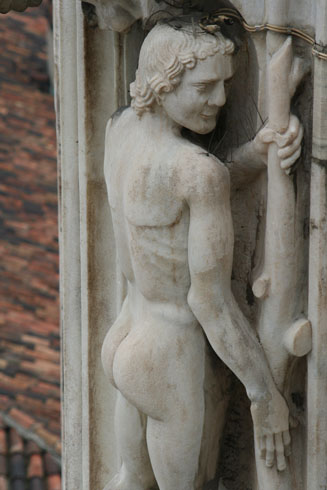
Giant statue taken from the roof, Milan cathedral
420 statues are made of marble.
They portray saints, bishops and other political and saint figures. One of them represents Napoléon Bonapartre, to thank him for finishing the facade in the early 19th century.
About fifty statues were destroyed during WWII.
Architects and artists to remember:
- Pellegrino Pelligrini architect (3 altars) arrived as chief engineer in 1571. He was hired by Archbishop Charles Borromeo.
- Francesco Brambilla, an Italian sculptor, worked on the choir of the main altar’s wooden chairs
- Marco d’Agrate, Lombard sculptor (1504-1574) worked on the statue of St. Bartholomew (a saint martyred and scalped alive – he stands with skin around his neck
- Builders of the facade are recognized in a tablet in Milan’s cathedral
- Work of Giuseppe Zanoja and Carlo Amati finished the Napoleonic facade
- French architects were brought to Milan to make sure it was made correctly: in 1389, Nicholas de Bonaventure and in January 1400, Jean Mignot from Paris.
- Leonardo da Vinci participated in some drawings for the cupola.
Archives and library:
If you are interested in history and want to do some research, the duomo has many drawings, photos, 8000 volumes of books and documents since 1386.
Religious art and objects to see:
Some were stolen by Napoleon but you still can admire some historical objects today like a Gospel book from 450 (in ivory) and one from the 11th century, some crosses, relics and vases.
The Duomo feasts and ceremonies:
Out of the ceremonies happening in the cathedral, the annual ceremony to know about is the Holy Nail ceremony. It is a yearly ritual celebrated the Saturday before September 14th.
The nail is said to be one of the nails, which held Jesus Christ on the crucifixion cross. It was brought to Milan during the Crusades.
For the last 550 years it has been put high above the altar in the apse.
Where is it exactly?
It is in the tabernacle. There is a little red light telling where it is. For two days each year it comes down and there is a holy nail mass. It used to be brought outside of the cathedral during the ceremony, but not anymore.
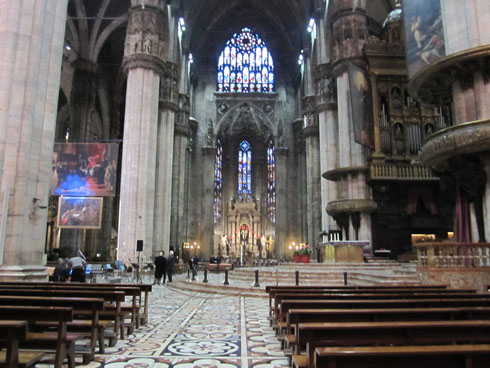
View of the choir, altar and marble floor
Renovation:
There has been some renovation done in the 20thcentury. The pillars in the drum were restored due to a static problem (1969-84). Work has been done on the spires, stain glass windows, pillars and facade (2003-2009).
When I went there, there was some construction work on the roof.
Additional information:
Where: Piazza del Duomo in the center of Milan
Price: 10 euros by lift (two lifts) and 6 euros by foot
Today it is the seat of Archbishop Angelo Scola, who was appointed this year by Pope Benedict XVI. Some say he could be the next pope.
The Veneranda Fabbrica del Duomo maintains it.
Tip: If you want you can also have a close up view of the cathedral by going to the restaurant of the department store, Rinascente.
I can’t wait for my next visit.
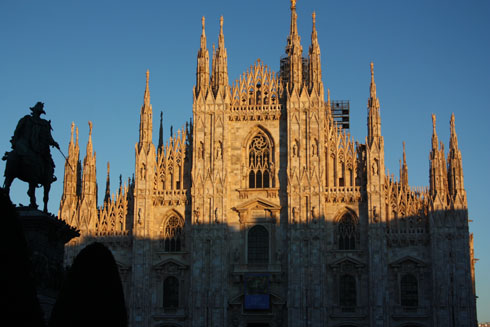
No matter if it is during Christmas surrounded by a beautiful Christmas tree, at sunset, at night or after the rain, the cathedral always magical to me.
Related Posts
One thought on “Cathedral Maria Nascente of Milan in Lombardy (Italy)”
Leave a Reply
This site uses Akismet to reduce spam. Learn how your comment data is processed.

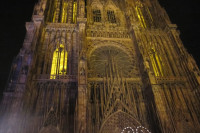
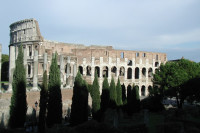
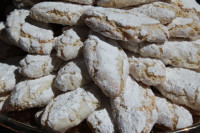
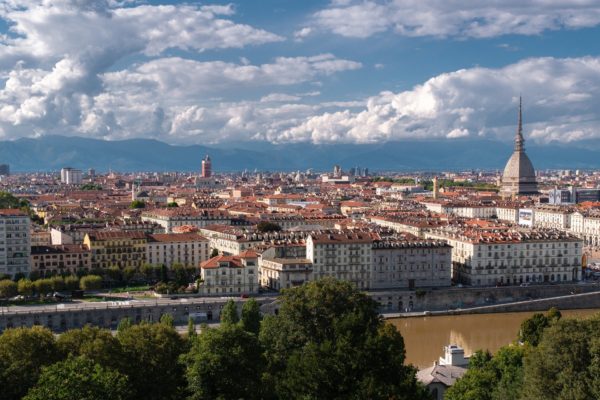
Virginio Pessina also worked on the doors and statuary of Milan Cathedral. He was a former pupil of Lombardi and finished off Lombardi’s commissions on his tutors’ death. He was a talented artist in his own right who was somewhat overshadowed by Lombardi’s reputation. They both worked on the doors and restoring or replacing the bomb damaged statues in the 40’s up to the late 60’s. I say this because there is a temptation to believe all artistic culture and craftsmanship died out after the great flowering of the renaissance.